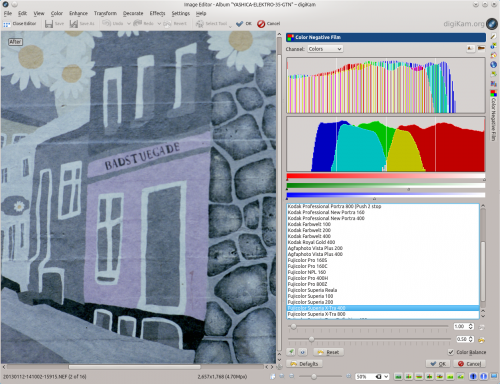Digikam/Negatives/da: Difference between revisions
(Created page with "Selv om '''digiKam''' først og fremmest er et program til behandlinh og organisering af digitale fotos, så har det også værktøjer til at arbejde med filmnegativer.") |
(Created page with "Før du kan behandle negativer i '''digiKam''' skal du digitalisere dem. Hvis du ikke har adgang til en filmscanner elleer et laboratorium som udbyder filmscanningstjenester, ...") |
||
| Line 6: | Line 6: | ||
Selv om '''digiKam''' først og fremmest er et program til behandlinh og organisering af digitale fotos, så har det også værktøjer til at arbejde med filmnegativer. | Selv om '''digiKam''' først og fremmest er et program til behandlinh og organisering af digitale fotos, så har det også værktøjer til at arbejde med filmnegativer. | ||
Før du kan behandle negativer i '''digiKam''' skal du digitalisere dem. Hvis du ikke har adgang til en filmscanner elleer et laboratorium som udbyder filmscanningstjenester, så kan du digitalisere film vej hjælp af et DSLR-kamera (der er en masse vejledninger i at gøre det på nettet). Resten af processes forudsætter, at du bruger denne måde at digitalisere negativerne. | |||
Open a RAW file containing a film negative in the editor (choose <menuchoice>Tools -> Image Editor</menuchoice> or press <keycap>F4</keycap>). Crop the original file and apply lens correction if necessary. Choose then <menuchoice>Color -> Invert</menuchoice> to transform the negative into a positive image. In case you work with the color negative, the converted image most likely requires some additional tweaking. First of all, the converted image is likely to have a strong blue tint. The easiest way to remove it is to use '''digiKam’s''' Auto-Correction tool. Choose <menuchoice>Color -> Auto-Correction</menuchoice> and select one of the presets. In many cases, the <menuchoice>Auto Levels</menuchoice> or <menuchoice>Equalize</menuchoice> presets do a decent job of correcting the colors. If the colors still look slightly off, you can adjust them further using the <menuchoice>Colors -> Color Balance</menuchoice> tool. | Open a RAW file containing a film negative in the editor (choose <menuchoice>Tools -> Image Editor</menuchoice> or press <keycap>F4</keycap>). Crop the original file and apply lens correction if necessary. Choose then <menuchoice>Color -> Invert</menuchoice> to transform the negative into a positive image. In case you work with the color negative, the converted image most likely requires some additional tweaking. First of all, the converted image is likely to have a strong blue tint. The easiest way to remove it is to use '''digiKam’s''' Auto-Correction tool. Choose <menuchoice>Color -> Auto-Correction</menuchoice> and select one of the presets. In many cases, the <menuchoice>Auto Levels</menuchoice> or <menuchoice>Equalize</menuchoice> presets do a decent job of correcting the colors. If the colors still look slightly off, you can adjust them further using the <menuchoice>Colors -> Color Balance</menuchoice> tool. | ||
Revision as of 06:22, 15 March 2013
Behandl negativer med digiKam
Fra Dmitri Popovs blog, 29. januar, 2013
Selv om digiKam først og fremmest er et program til behandlinh og organisering af digitale fotos, så har det også værktøjer til at arbejde med filmnegativer.
Før du kan behandle negativer i digiKam skal du digitalisere dem. Hvis du ikke har adgang til en filmscanner elleer et laboratorium som udbyder filmscanningstjenester, så kan du digitalisere film vej hjælp af et DSLR-kamera (der er en masse vejledninger i at gøre det på nettet). Resten af processes forudsætter, at du bruger denne måde at digitalisere negativerne.
Open a RAW file containing a film negative in the editor (choose or press F4). Crop the original file and apply lens correction if necessary. Choose then to transform the negative into a positive image. In case you work with the color negative, the converted image most likely requires some additional tweaking. First of all, the converted image is likely to have a strong blue tint. The easiest way to remove it is to use digiKam’s Auto-Correction tool. Choose and select one of the presets. In many cases, the or presets do a decent job of correcting the colors. If the colors still look slightly off, you can adjust them further using the tool.

The Invert feature in combination with an Auto-Correct preset provides a quick-and-dirty way of converting negatives, but digiKam has another tool designed specifically for processing color negatives. To access it, choose the command. The Color Negative Film interface contains several handy features that can help you to convert the negative and tweak the resulting image. While the Invert tool uses a generic profile for converting negatives, the Color Negative Film interface offers film profiles for many popular film types. So the first step is to select the appropriate profile. For better results, try to enable the option, too. If the used film is not in the list, you can use the profile as a fall back.
Although choosing the matching film profile may yield a better result, the converted image may still require some work. In most cases, you may need to adjust the white point to remove the remaining blue tint. You can do this either manually or automatically using the appropriate buttons. Usually, the automatic white point adjustment does the job, but the resulting image needs to be brightened up by adjusting the slider.
